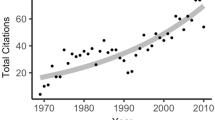Abstract
This comment presents current and emerging areas of research which the U.S. National Science Foundation believes have special promise for advancing ecosystem science. These areas are: (1) major element cycle interactions; (2) trace element and organic compound controls on ecosystem dynamics; (3) the role of consumers on ecosystem dynamics; (4) ecosystem dynamics in contrasting environments; (5) landscape ecology; and (6) enhancement of theory and methodology. The Ecosystem Studies Program of the National Science Foundation has identified these as areas to be emphasized in its long range planning program (revised March, 1985). Biogeochemical studies are emphasized in many of these research priority areas.
Similar content being viewed by others
References
Callahan, J.T. 1985. Long-term ecological research: a national perspective. Proceedings for the American Society of Civil Engineering, Specialty Conference; Hydraulics and Hydrology in the Small Computer Age, p. 856–861.
Clarholm, M. 1981. Protozoan grazing of bacteria in soil — impact and importance. Microbial Ecology 7:343–350.
Howarth, R.W. and J.J. Cole. 1985. Molybdenum availiability, nitrogen limitation and phytoplankton growth in natural waters. Science 229:653–655.
Ingham, R.E. and J.K. Detling. 1984. Plant-herbivore interactions in a North American mixed-grass prairie. III. Soil nematode population and root biomass dynamics on a black-tailed prairie dog colony and an adjacent uncolonized area. Oecologia 63:307–313.
Lodhi, M.A.K. and K.T. Killingbeck. 1980. Allelopathic inhibition of nitrification and nitrifying bacteria in a ponderosa pine (Pinus ponderosa Dougl.) community. American Journal of Botany 67 (10):1423–1429.
Martin, J.S. and M.M. Martin. 1982. Tannin assays in ecological studies: Lack of correlation between phenolics, proanthocyanidins and protein-precipitating constituents in mature foliage of six oak species. Oecologia (Berl.) 54:205–211.
Mattson, W.J. and Addy . 1975. Phytophagous insects as regulators of forest primary production. Science 190:515–522.
McClaugherty, C.A., J. Pastor, J.D. Aber and J.M. Melillo. 1985. Forest litter decomposition in relation to soil nitrogen dynamics and litter quality. Ecology 66:266–275.
McGill, W.B. and E.K. Christie. 1983. Biogeochemical aspects of nutrient cycle interactions in soils and organisms. pp. 271–301.In Bolin, B. and R.B. Cook (eds), The Major Biogeochemical Cycles and Their Interactions. SCOPE 21. John Wiley and Sons, New York.
Meentemeyer, V. 1978. An approach to the biometeorology of decomposer organisms. International Journal of Biometeorology. 22:94–102.
Naiman, R.J. and J.M. Melillo. 1984. Nitrogen budget of a subartic stream altered by beaver (Castor canadensis). Oecologia 62:150–155.
NSF 84–336. 1986. Federal funds for research and development: fiscal years 1983, 1984 and 1985. Surveys of science resources series, vol. XXXIII. National Science Foundation.
O'Neill, R.V., D.L. DeAngelis, J.B. Waide and T.F.H. Allen. 1986. A Hierarchical Concept of Ecosystems. Princeton Univ. Press (in press).
Rice, E.L. and S.K. Pancholy. 1974. Inhibition of nitrification by climax ecosystems. III. Inhibitors other than tannins. American Journal of Botany 61 (10):1095–1103.
Risser, P.G., J.R. Karr and R.T.T. Forman. 1984. Landscape ecology, directions and approaches. Illinois Natural History Survey Special Publication Number 2. 18 pp.
Robinson, R. 1974. Metabolism and function of alkaloids in plants. Science 184:430–435.
Rorison, H. 1985. Nitrogen source and the tolerance ofDeschampsia flexuosa, Holcus lanatus andBromus erectus to aluminum during seedling growth. Journal of Ecology 73:83–90.
Silvester, W.B. 1985. Molybdenum limitation of asymbiotic nitrogen fixation in forests of Pacific Northwest America. Soil Biology and Biochemistry (submitted).
Swift, M.J., O.W. Heal and J.M. Anderson. 1979. Decompostion in terrestrial ecosystems. University of California Press, Berkeley, California, USA.
Watt, A.S. 1947. Pattern and process in the plant community. Journal of Ecology. 35:1–22.
Whitford, W.G., Y. Steinberger and G. Ettershank. 1982. Contributions of subterranean termites to the ‘economy’ of Chichuahuan desert ecosystems. Oecologia 55:298–302.
Author information
Authors and Affiliations
Rights and permissions
About this article
Cite this article
Gosz, J.R. Biogeochemistry research needs: observations from the ecosystem studies program of The National Science Foundation. Biogeochemistry 2, 101–112 (1986). https://doi.org/10.1007/BF02186968
Issue Date:
DOI: https://doi.org/10.1007/BF02186968




